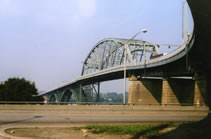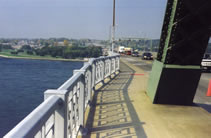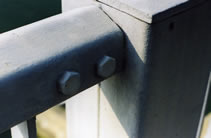Zinc-Rich Topcoat with 95 Percent Zinc Dust Performs Well on Peace Bridge
The steel railings of the Peace Bridge, which spans the Niagara River between Buffalo, NY, and Fort Erie, Ontario, are protected from corrosion by a 95 percent zinc-rich topcoat. Initially specified for touch-up of rust spots in the late 1960s shortly after the installation of hot-dip galvanized railings, the material was used to coat the entire railing in 1975 and again in 1986. In the summer of 1990, the railings were pronounced in excellent shape with no visible signs of rust in a 150-page condition report compiled by the Buffalo, NY consulting firm of DeLeuw, Cather & Company.
The total length of the Peace Bridge and terminals is 4,000 ft (1,200 m). It is located in a hostile environment where it is exposed to harsh winters, high winds, violent storms from Lake Erie, and a small amount of road salt (10 percent mixture with grit). The Buffalo and Fort Erie Public Bridge Authority owns and operates the Peace Bridge, which is the largest single crossing between the U.S. and Canada (accommodating 8,500,000 vehicles per year).
Built in 1927, the steel arch-and-girder bridge originally had steel-reinforced cement railings, which were replaced with the present hot-dip galvanized railings in 1964-1965.
After 5 years of service, the hot-dip railings were showing blushing, and the authority decided to use a cold galvanizing compound to touch up the blushing. The condition of the bridge is monitored closely by extensive annual inspections by independent consulting engineering firms and the Authority staff.
In 1974, when it was determined that repainting of the bridge was needed, testing of zinc-rich coatings began. Several different organic zinc-rich coatings were tested on the bridge railings. Small sections were prepared with wire brushing and an acid wash solution compatible with the topcoats. Then, the areas were painted with each of the coatings being tested. Dry film thicknesses were between 3 and 4 mils (75 and 100 µ) for each coating tested. The areas were located in heavily exposed stretches of the railing, where the original, hot-dip galvanized surface was blushing. The zinc-rich primers were left on the railing for a period of 1 year from the date of application. Results were then compared. It was important to have actual field results since the Lake Erie/Niagara location has a high degree of exposure to extremely corrosive elements.
The products tested included compounds with a zinc content of 95 percent, 90 percent, 85 percent, and 80 percent in the dried film of the coating. Visual inspection revealed that the 95 percent zinc-rich topcoat surpassed the other compounds in terms of surface protection and durability. The other coatings tested did not fail within a year, but their performance was observed to be notably less than the 95 percent zinc solids material.
Based on these test results and its performance as a repair compound in the past, the 95 percent zinc topcoat was specified for the coating of all railings when the bridge was painted in 1975 and again in 1986.
George Nicholas, president of Essen Contracting Company in Buffalo, the firm which won the contract for painting the bridge in 1975 and for re-painting in 1986, said of the zinc-rich topcoat, "the steel railings have held up very well, especially considering their constant exposure to the corrosive effects of moisture from Lake Erie and the Niagara River, the severe Buffalo winters, and the light road salting in the area."
In the case of the Peace Bridge, no abrasive blasting of the railing surface was necessary. The surface of the metal was prepared by wire brushing, application of a phosphoric acid wash, wiping clean, and then applying the zinc-rich topcoat with a brush. Dry film thickness was 3-4 mils (75-100 µ). Since there is a six-foot (two-meter) sidewalk on each side of the bridge, preparing and painting the surface was accomplished with relative ease. The fact that blasting was not required was especially significant since it eliminated potential problems in terms of meeting all U.S. EPA and Canadian regulations and safety standards, while greatly reducing the overall cost and logistical complexity of the project. In both 1975 and 1986, all work was accomplished without any interruption of traffic. The Peace Bridge has 3 reversible lanes for vehicular traffic and terminals located on both the Buffalo and Fort Erie sides.
The nearly contaminant-free surface requirements of other galvanizing methods compared with the minimal surface preparation requirements of the 95 percent zinc-rich topcoat made it a logical choice for this project. According to the manufacturer of the product, the acid-wash prior to application was an optional step requested by the bridge authority as an added precaution.
The zinc-rich topcoat used on the Peace Bridge was manufactured by ZRC Products Company (Quincy, MA). The coating contractor was Essen Contracting Company (Buffalo, NY). Engineering and condition reports were prepared by DeLeuw, Cather & Company (Buffalo, NY). Surface tests were conducted by the Buffalo and Fort Erie Public Bridge Authority (Buffalo, NY).
From Buffalo and Fort Erie
Public Bridge Authority and ZRC Products Co.
Journal of Protective Coatings & Linings





